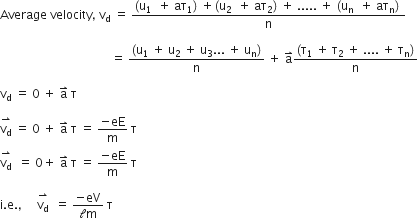 Short Answer Type
Short Answer Type Long Answer Type
Long Answer TypeThe current flowing through a conductor is given by I = neAvd.
(i) Identify each term in the equation.
(ii) Obtain an expression for vd, if the current flowing through the conductor of length I has its ends maintained at a potential difference of V volts.
i) In expression
I = n e AVd
where
I = Current flowing through the conductor
n = Number of free electrons
e = Charge on the electron
A = Area of cross-section
Vd = Drift velocity.
(ii) Let e is the electronic charge and
m = Mass of each electron.
V = Potential difference across the conductor
I = Length of conductor
Then,
E = ![]() ... (i)
... (i) 
Hence, under the influence of electric field E electron experience a force given by,
F = qE
Acceleration of each electron is,
a = e E / m ... (ii)
At any instant of time, the velocity of an electron having thermal velocity u1 will be ![]() where
where ![]() of the time that has elapsed since its last collision.
of the time that has elapsed since its last collision.
So, for n electron, 
where, ![]() is the relaxation time.
is the relaxation time.
(i) Write an expression for Biot-Savart’s law in the vector form. Write an expression for the magnetic field at the centre of a circular coil of radius R, with N turns and carrying a current I.
(ii) A helium nucleus completes one round of a circle of radius 0.8 m in 2 seconds. Find the magnetic field at the centre of the circle.
 where Irms is the root mean square value of alternating current and I0 is its peak value.
where Irms is the root mean square value of alternating current and I0 is its peak value.
(i) Derive an expression for the fringe width ‘y’ in Young’s double slit experiment. Use X as the wavelength of the monochromatic source, D as the distance of the screen from the slits and d as the distance of separation between the slits.
(ii) How does the fringe pattern change if the monochromatic source of light in the above experiment is replaced by a white source of light ?
